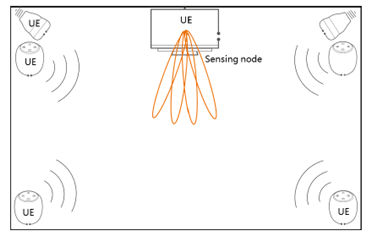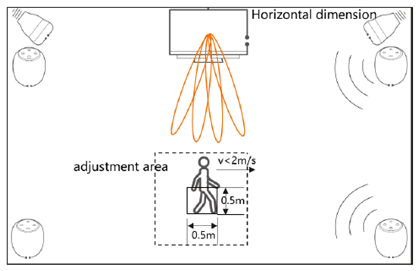Content for TR 22.837 Word version: 19.3.0
0…
4
5…
5.2…
5.3…
5.4…
5.5…
5.6…
5.7…
5.8…
5.9…
5.10…
5.11…
5.12…
5.13…
5.14…
5.15…
5.16…
5.17…
5.18…
5.19…
5.20…
5.21…
5.22…
5.23…
5.24…
5.25…
5.26…
5.27…
5.28…
5.29…
5.30…
5.31…
5.32…
6…
7…
5.25 Use Case on immersive experience based on sensing
5.25.1 Description
5.25.2 Pre-conditions
5.25.3 Service Flows
5.25.4 Post-conditions
5.25.5 Existing features partly or fully covering the use case functionality
5.25.6 Potential New Requirements needed to support the use case
...
...
5.25 Use Case on immersive experience based on sensing p. 70
5.25.1 Description p. 70
Sensing based on the 5G signals is a technology using the difference between wireless signals and its reflective signals including the Doppler frequency shift, time of flight (ToF), amplitude variation and so on, to sense the surroundings. The information collected during sensing cannot be directly understood by human beings, providing good privacy protection. Along with 5G stepping into the home, more interesting functions can be introduced based on the sensing using 5G signals.
It will be fantastic to have an immersive audio and light experience when watching movies and listening to music in the home. The speakers can provide this kind of audio experience if they can know the position of each other and also the user. Usually, to have immersive audio experience, several speakers are needed. Ranging technology can help the speakers to determine position relative to each other and this gives a chance for speakers to provide a fantastic experience together to a listener by adjusting the audio field at a place when the listener stays at that special place.
Different from ranging service where only the UE's position can be identified, sensing can identify the relative position of the reflector even the reflector is not a UE. If the speakers can obtain the sensing results, this will give a chance to the speakers to follow the listener and provide an immersive audio experience, even when the listener is moving around. The speakers can follow the position of the human and adjust the audio field anytime anywhere. Similar to the audio case, if the smart light can obtain the sensing results, the light can also track the user anytime anywhere to provide an immersive experience.
For the immersive experience scenario, the audio field and light adjustment should be based on the user's position. For example, the smart screen, lights and speakers can provide immersive sound and light experience for the user who sits at the sofa area (around 2~3m2 area) and at the same time lower the sound volume and turn down the light at other places of the home avoiding the interference on others. The sensing node (e.g., smart screen, i.e., a UE) can perform sensing operations to track the user's movement using RF signals [29] and provide the information to the speakers and lights for adjustment. Then both the lights and speakers can provide a cosy zone around the user.
In home, there is usually a mixed deployment of smart screen, lights, and speakers. We take smart screen as the sensing node as an example. Assume that the smart screen, the smart lights, and the speakers are placed in the drawing-room, and the smart screen can sense the object in the room as shown in Figure 5.25.1-1. The smart screen (i.e., UE) can receive the reflected sensing signals transmitted by UEs in the room, or by the gNB to perform sensing operation on the user in the room.

Figure 5.25.1-1: Example deployment of the smart screen, speakers and lights
(⇒ copy of original 3GPP image)
(⇒ copy of original 3GPP image)
The smart screen can track the user's position via sensing operation. Each user is assumed to occupy an area 0.5m * 0.5m and move with a speed lower than 2m/s in horizontal dimension. Then the audio field and light can be adjusted based on the user position (e.g. an area 1.5m * 1.5m) to avoid the experience deterioration even when the user is walking around.
To identify multiple users in the room, in the horizontal dimension, the resolution requires to distinguish objects as large as 0.5m. With higher accuracy on distance, each user in the room can be identify with a more accurate location such as 0.2m, the light and audio can target the user better [30]. If the results are accurate but out of date due to the movement of the user, this will also degrade the experience as the cosy zone is lagging the movement of the user. Consider the audio field and lights are adjusted in an area with 1.5m * 1.5m, to avoid the experience deterioration, the service latency should smaller than 0.5m/2m/s, i.e., 250ms. To track the user's movement, the results need to be refreshed in 250ms, i.e., 4 times per second (4 Hz).

5.25.2 Pre-conditions p. 71
This use case is about Tom's home theatre plan. Tom bought a set of speakers, and placed them in his home to create an immersive audio experience. Tom also bought a set of smart lights to create an immersive light experience. Together with a smart screen in home, these smart devices compose the home theatre. According to the instruction of the speakers, and also based on the availability of audio and power wiring Tom distributed the speakers in his living room. The smart lights are installed on the ceiling of the room. After detecting the position of each distributed speakers, the home theatre system can adjust the audio field in Tom's home. After detecting the position of smart lights, the home theatre system can control the light variation in home. This detection mechanism of the speakers and smart lights is outside the scope of this document.
There exists a sensing device in the home, which can sense Tom's position without requiring Tom to take a UE with him. For example, the sensing node is the smart screen belonging to the home theatre system at Tom's home. Based on the sensing results from the sensing node, the home theatre system can adjust the audio field and light based on the sensing results.
The home theatre system can be deployed by user where the smart screen, lights and speakers communicate with each other via direct device communication using unlicensed band. As an alternative, the home theatre system can be deployed with the help of operator using licensed band when the units of the home theatre system are in coverage. In this case, operator can control the performing of sensing operation based on the location of the deployment of the home theatre.
5.25.3 Service Flows p. 72
Tom activates his home theatre and the speaker begin to play music based on the audio on demand. The sensing device in the room (i.e., Smart screen) performs sensing operation and the sensing results begin helping adjust the audio field.

Tom immerses himself in music and begins to dance. The sensing device (e.g., smart screen) tracks Tom's position via the processing of the receiving sensing signals, the Sensing result is calculated, and the Sensing result is sent to the control unit of the home theatre system.
Based on the sensing results, the home theatre system can adjust the audio field and lights according to Tom's movement.
Thanks for the sensing service provided by the sensing node (e.g. smart screen), no matter where Tom stands, he always experiences the best surround sound and tracking light.
5.25.4 Post-conditions p. 72
Thanks to the sensing service provided in the intelligent home, Tom can have an immersive experience via his home theatre.
5.25.5 Existing features partly or fully covering the use case functionality p. 72
None.
5.25.6 Potential New Requirements needed to support the use case p. 72
[PR 5.25.6-1]
The 5G system shall be able to configure and authorize sensing for a Sensing device or a group of Sensing devices when using licensed spectrum based on the Sensing device's location.
[PR 5.25.6-2]
The 5G system shall be able to enable a Sensing device to perform sensing with licensed band under operator's control based on the Sensing device's location.
[PR 5.25.6-3]
The 5G system shall be able to enable UEs without 5G coverage to use unlicensed spectrum to perform sensing.
[PR 5.25.6-4]
Subject to user consent and national or regional regulation, based on operator policy, the 5G system shall be able to allow a Sensing device to provide sensing results to a trusted third party.
[PR 5.25.6-5
The 5G system shall be able to provide sensing with following KPIs:
| Scenario | Sensing service area | Confidence level [%] | Accuracy of positioning estimate by sensing (for a target confidence level) | Accuracy of velocity estimate by sensing (for a target confidence level) | Sensing resolution | Max sensing service latency [ms] | Refreshing rate [s] | Missed detection [%] | False alarm [%] | |||
|---|---|---|---|---|---|---|---|---|---|---|---|---|
| Horizontal
[m] |
Vertical [m] | Horizontal [m/s] | Vertical [m/s] | Range resolution [m] | Velocity resolution (horizontal/ vertical) [m/s x m/s] | |||||||
| Immersive experience | Indoor | 95 | 0.5 | 0.5 | 0.1 | N/A | 0.5 | N/A | 250 (granularity of field is 1.5m x 1.5m) | 0.25 | 5 | 5 |
|
NOTE:
The terms in Table 5.25.6-1 are found in clause 3.1.
|
||||||||||||